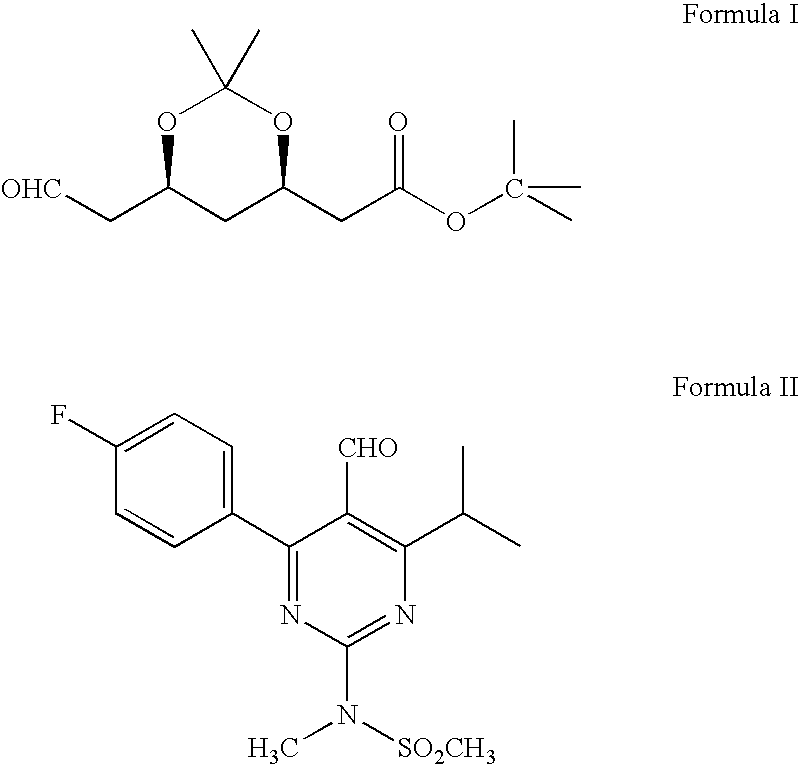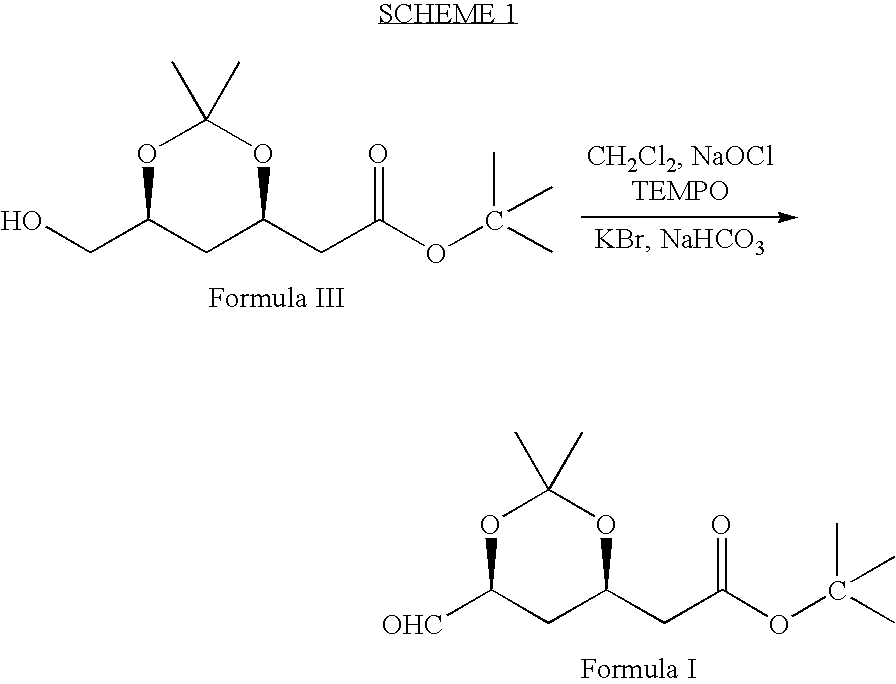Processes to produce intermediates for rosuvastatin
a technology of rosuvastatin and intermediates, applied in the field of rosuvastatin intermediates production processes, can solve the problems of high cost of chemicals, unsuitable for large-scale industrial applications, and inability to meet the needs of large-scale industrial applications,
- Summary
- Abstract
- Description
- Claims
- Application Information
AI Technical Summary
Benefits of technology
Problems solved by technology
Method used
Image
Examples
example 1
Preparation of Tert.butyl-2 [(4R,6S)-6-Formyl-2,2-dimethyl-1,3-dioxan-4-yl]acetate (Formula I)
[0036]2,2,6,6-tetramethyl piperidinyl oxy free radical (TEMPO) (0.2 g), potassium bromide (9.6 g) and sodium bicarbonate (90 g) were dissolved in methylene chloride (600 ml) and stirred the contents together at 0–5° C. A solution of (4R-cis)-6-(hydroxymethyl)-2,2-dimethyl-1,3-dioxane-4-acetic acid, 1,1-dimethylethyl ester of Formula III (100 g) in methylene chloride (400 ml) was added to the above solution at 0–5° C. To this solution 10% sodium hypochlorite solution (159 ml) (NaOCl) was added at 0–5° C. Again sodium bicarbonate (96 g) and followed by 10% sodium hypochlorite solution was added to the reaction mass. Reaction mass was maintained for 1–2 hours at 0–5° C. and filtered through perlite. The organic layer was separated and washed with 10% sodium thiosulfate solution (250 ml), then water (250 ml) followed by saturated sodium chloride solution (250 ml). Organic layer was distilled at...
example 2
Preparation of 4-(4-fluorophenyl)-6-isopropyl-2-(N-methyl-N-methylsulphonyl amino)-5-pyrimidinecarbaldehyde (Formula II)
[0037]2,2,6,6-tetramethyl piperidinyl oxy free radical (TEMPO) (5 mg), potassium bromide (0.385 g) and sodium bicarbonate (3.63 g) were dissolved in methylene chloride (150 ml) and stirred together at 0–5° C. A solution of 4-(4-flourophenyl)-6-isopropyl-2-(N-methyl-N-methylsulfonylamino)pyrimidin-5-yl]methanol (11 g) in methylene chloride (25 ml) was added to the above solution at 0–5° C. To this solution 10% sodium hypochlorite solution (24.2 g) was added at 0–5° C. Reaction mass was maintained for 1–2 hours at 0–5° C. and filtered through perlite. Organic layer was separated and washed with 10% sodium thiosulfate solution (200 ml), water (200 ml) followed by saturated sodium chloride solution (150 ml). Organic layer was distilled off under reduced pressure and the title compound was isolated from the residue with cyclohexane (75 ml). Yield: 9.5 g.
PUM
| Property | Measurement | Unit |
|---|---|---|
| temperatures | aaaaa | aaaaa |
| temperatures | aaaaa | aaaaa |
| cryogenic temperatures | aaaaa | aaaaa |
Abstract
Description
Claims
Application Information
 Login to View More
Login to View More - R&D
- Intellectual Property
- Life Sciences
- Materials
- Tech Scout
- Unparalleled Data Quality
- Higher Quality Content
- 60% Fewer Hallucinations
Browse by: Latest US Patents, China's latest patents, Technical Efficacy Thesaurus, Application Domain, Technology Topic, Popular Technical Reports.
© 2025 PatSnap. All rights reserved.Legal|Privacy policy|Modern Slavery Act Transparency Statement|Sitemap|About US| Contact US: help@patsnap.com



